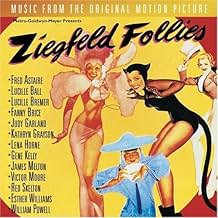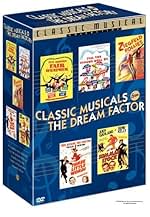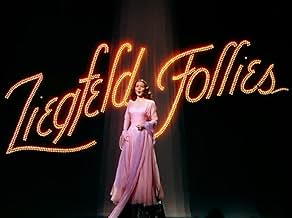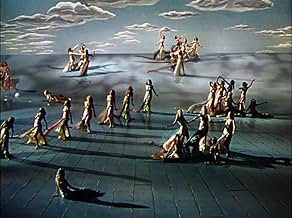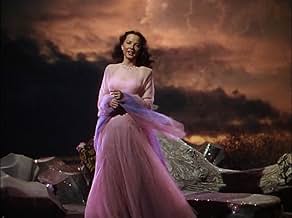AVALIAÇÃO DA IMDb
6,4/10
3,9 mil
SUA AVALIAÇÃO
Adicionar um enredo no seu idiomaThe late, great impresario Florenz Ziegfeld Jr. looks down from Heaven and ordains a new revue in his grand old style.The late, great impresario Florenz Ziegfeld Jr. looks down from Heaven and ordains a new revue in his grand old style.The late, great impresario Florenz Ziegfeld Jr. looks down from Heaven and ordains a new revue in his grand old style.
- Prêmios
- 1 vitória e 1 indicação no total
Avaliações em destaque
No doubt the jaded postmodern cynical viewer will find plenty to pick apart in this fluff (facile metaphysics, etc.). That is their loss.
This is not one of the great MGM musicals, but at its best it does what great musicals do: it sweeps you along in a kaleidoscope of color, movement and sound. And because of these qualities this trifle IS art as surely as Citizen Kane or La Promesse are. Cinema is not just an art of--or forum for-- philosophy; it is an art of the color palette, and with The Ziegfeld Follies the technical forces of a great studio created a sometimes exquisite canvas to behold. Unfortunately, like many old films, the canvas is fading.
I first saw this film 20 years ago projected from an exceptional 16 millimeter print that brought out the full richness of the Technicolor cinematography. None of the video versions I've seen since have come close. The same is true for the 1949 John Ford western, She Wore a Yellow Ribbon, which I saw many years ago in an unbelievably painterly 16mm Technicolor print. Prints of that film shown on the AMC network don't even come close to the richness of that print.
Its color alone is enough to make The Ziegfeld Follies visually entertaining for me, and that print I saw long ago convinces me that is one of the 10 or 20 most beautiful color films ever made. The merry go round scene (with Lucille Ball as I recall) in hot garish pink was particularly striking visually.
I contend that any film, even marginal or bad ones, made in the extinct and impossible to resurrect Technicolor process is worthy of seeing, because its very usage constitutes a lost art form in and of itself.
Like Ziegfeld Follies, middling films such as Kid Millions (1934), Trail of the Lonesome Pine (1936), Jesse James (1939), Down Argentine Way (1940), The Gang's All Here (1943) and The Captain from Castile (1947) are worth seeing almost exclusively because of their amazing color schemes.
The biggest crack about "Tech," as cine buffs call it, is that it was not "realistic" color. Bogus line of reasoning, as no cinematic color process can ever be realistic in the sense of replicating human sight. OK maybe Roger Deakins came close in "Sid and Nancy." Admiring Ziegfeld Follies solely for its color may not be enough for you, but it's enough for me in our era of dreary cinematic color.
This is not one of the great MGM musicals, but at its best it does what great musicals do: it sweeps you along in a kaleidoscope of color, movement and sound. And because of these qualities this trifle IS art as surely as Citizen Kane or La Promesse are. Cinema is not just an art of--or forum for-- philosophy; it is an art of the color palette, and with The Ziegfeld Follies the technical forces of a great studio created a sometimes exquisite canvas to behold. Unfortunately, like many old films, the canvas is fading.
I first saw this film 20 years ago projected from an exceptional 16 millimeter print that brought out the full richness of the Technicolor cinematography. None of the video versions I've seen since have come close. The same is true for the 1949 John Ford western, She Wore a Yellow Ribbon, which I saw many years ago in an unbelievably painterly 16mm Technicolor print. Prints of that film shown on the AMC network don't even come close to the richness of that print.
Its color alone is enough to make The Ziegfeld Follies visually entertaining for me, and that print I saw long ago convinces me that is one of the 10 or 20 most beautiful color films ever made. The merry go round scene (with Lucille Ball as I recall) in hot garish pink was particularly striking visually.
I contend that any film, even marginal or bad ones, made in the extinct and impossible to resurrect Technicolor process is worthy of seeing, because its very usage constitutes a lost art form in and of itself.
Like Ziegfeld Follies, middling films such as Kid Millions (1934), Trail of the Lonesome Pine (1936), Jesse James (1939), Down Argentine Way (1940), The Gang's All Here (1943) and The Captain from Castile (1947) are worth seeing almost exclusively because of their amazing color schemes.
The biggest crack about "Tech," as cine buffs call it, is that it was not "realistic" color. Bogus line of reasoning, as no cinematic color process can ever be realistic in the sense of replicating human sight. OK maybe Roger Deakins came close in "Sid and Nancy." Admiring Ziegfeld Follies solely for its color may not be enough for you, but it's enough for me in our era of dreary cinematic color.
If a star-studded Hollywood cast from the 'Golden' years makes you enjoy a film, that alone will be enough to tide you over the nearly 2 hours of this musical bonanza. It seems nearly everyone is present.
True to the nature of the revue, there's no story and just a series of vignettes that come and go. Among them, Fred Astaire and Gene Kelly have a dance show-off, your only chance to see one from this time. Esther Williams gives us a lovely underwater ballet, I would like to see more of her.
In spite of the scale of the production, the lavish sets and elaborate costumes, this is not, of course, aristocratic entertainment for those with a refined taste in music and dance but low brow frill aimed at the broad audience.
The revue was television of its time - an opportunity to shift among a few fluffy entertainments after a long day, nothing demanding our engagement beyond the few minutes of a skit. These days it seems to survive in SNL. The bits here alternate between broad comedy skits and song and dance numbers.
It's not bad, not particularly great either. It's not what I look for in a musical, and I will always opt for the fuller engagement of long narrative.
More interesting for me here are all the self-referential bits.
In the Astaire/Kelly show-off Fred, established musical royalty, plays a joke of pretending to not know who Kelly is.
Judy Garland enters her segment as herself, musing to a chorus of reporters about preferring song and dance roles rather than dramatic.
These people are here as themselves, the veneer of fiction is thin, opportunity for scenery and costume. You'll see some gorgeous examples of both, among the standouts for me being the all red ballroom in which Astaire swindles the rich countess and the dreamy finale, with chorus girls swirling through billows of bubbly foam. Briefly glimpsed among them is Cyd Charissee in her first appearance.
The whole is framed as Ziegfeld in heaven reminiscing about the shows he put on.
My favorite bit is the Chinatown skit with Astaire as a poor coolie dreaming about a woman he passes by on the street. His unrequited love becomes a dance they have together holding hand fans.
True to the nature of the revue, there's no story and just a series of vignettes that come and go. Among them, Fred Astaire and Gene Kelly have a dance show-off, your only chance to see one from this time. Esther Williams gives us a lovely underwater ballet, I would like to see more of her.
In spite of the scale of the production, the lavish sets and elaborate costumes, this is not, of course, aristocratic entertainment for those with a refined taste in music and dance but low brow frill aimed at the broad audience.
The revue was television of its time - an opportunity to shift among a few fluffy entertainments after a long day, nothing demanding our engagement beyond the few minutes of a skit. These days it seems to survive in SNL. The bits here alternate between broad comedy skits and song and dance numbers.
It's not bad, not particularly great either. It's not what I look for in a musical, and I will always opt for the fuller engagement of long narrative.
More interesting for me here are all the self-referential bits.
In the Astaire/Kelly show-off Fred, established musical royalty, plays a joke of pretending to not know who Kelly is.
Judy Garland enters her segment as herself, musing to a chorus of reporters about preferring song and dance roles rather than dramatic.
These people are here as themselves, the veneer of fiction is thin, opportunity for scenery and costume. You'll see some gorgeous examples of both, among the standouts for me being the all red ballroom in which Astaire swindles the rich countess and the dreamy finale, with chorus girls swirling through billows of bubbly foam. Briefly glimpsed among them is Cyd Charissee in her first appearance.
The whole is framed as Ziegfeld in heaven reminiscing about the shows he put on.
My favorite bit is the Chinatown skit with Astaire as a poor coolie dreaming about a woman he passes by on the street. His unrequited love becomes a dance they have together holding hand fans.
If you get easily bored with those old movies that seem to roll and roll forever, this is for you. It really has no plot, but you really don't need one. You could call this movie the Grand Ball, because it really is a set of dances. (Except for a few comedy scenes) Overall, I strongly believe that it is a really good movie, especially in those Fred Astaire numbers (Here's to the Girls, This Heart of Mine, and the Limehouse Blues) This movie is a real MUST for classic movie and Ziegfeld lovers alike.
This film is just what it says on the tin, a collection of pieces and sketches similar to those you would have seen in a real Ziegfeld show.
Introduced from Heaven by Ziegfeld himself (William Powell reprising his role of ten years earlier), the acts are rolled out one by one for our appreciation and enjoyment.
High points which spring to mind are Fred Astaire as a jewel thief, charming Lucille Bremer; and as a Chinese n'er do well wishing he could get Bremer the fan she wants. Cyd Charisse and others dancing through bubbles as Kathryn Grayson warbles 'Beauty'. Judy Garland as 'the great lady' mocking Greer Garson. And of course 'The Babbitt and the Bromide' which teams Astaire and Gene Kelly for the first time.
The comedy segments sit less well today and all are too long, however, they're not bad. Keenan Wynn struggles with a dumb telephone operator; Victor Moore has a tightwad lawyer who gets him into jail; Fanny Brice wins the Irish sweepstake; and Red Skelton advertises Guzzler's Gin.
Add Lucille Ball and her cat girls, a touch of La Traviata, and a bevy of lovelies to open and close the show, and you can see why this film was a hit on its first release.
Good for historical interest and the frequent highs, but you might find your attention wandering now and then.
Introduced from Heaven by Ziegfeld himself (William Powell reprising his role of ten years earlier), the acts are rolled out one by one for our appreciation and enjoyment.
High points which spring to mind are Fred Astaire as a jewel thief, charming Lucille Bremer; and as a Chinese n'er do well wishing he could get Bremer the fan she wants. Cyd Charisse and others dancing through bubbles as Kathryn Grayson warbles 'Beauty'. Judy Garland as 'the great lady' mocking Greer Garson. And of course 'The Babbitt and the Bromide' which teams Astaire and Gene Kelly for the first time.
The comedy segments sit less well today and all are too long, however, they're not bad. Keenan Wynn struggles with a dumb telephone operator; Victor Moore has a tightwad lawyer who gets him into jail; Fanny Brice wins the Irish sweepstake; and Red Skelton advertises Guzzler's Gin.
Add Lucille Ball and her cat girls, a touch of La Traviata, and a bevy of lovelies to open and close the show, and you can see why this film was a hit on its first release.
Good for historical interest and the frequent highs, but you might find your attention wandering now and then.
Ziegfeld Follies is a musical comedy from 1946, from the time when they made lots of musical movies.There really isn't a plot in this movie, but who needs one anyway.As long the musical numbers are working, you really don't need a plot in a movie like this.And then there are also some really funny sketches in the movie.Especially I liked Red Skelton's and Keenan Wynn's acts.They really make you laugh.And then it is great fun to watch Fred Astaire's and Gene Kelly's musical number.This was their only musical act together.Ziegfeld Follies has many great musical numbers.The younger generation doesn't care so much about musical movies, but I'm a teen ager and I like these old musical movies.These kind of movies make me miss those times, and I wasn't even born back then!
Você sabia?
- CuriosidadesThe machine producing the bubbles for the finale was responsible for one of the greatest filming fiascoes in movie history. On the first day of filming the finale, the gas produced by the bubbles caused Vincente Minnelli's cameraman to faint on top of a forty foot lift. While Minnelli struggled to stop his cameraman from falling, the bubbles continued to pour from the machine to such an extent that the soundstage was flooded with bubbles, and no one could get close enough to turn the machine off. Eventually, the fire brigade was called to turn stop it. Afterwards, teams of workers used large rackets to keep them under control, but the gas from the bubbles remained a constant hazard, and between each take Minnelli would order the soundstage's doors open so the cast and crew could breathe. James Melton filmed with a wet handkerchief in his mouth to protect his voice. Fred Astaire and Lucille Bremer's dance was removed completely, since in every take of them, the bubbles obscured part of their face.
- Erros de gravaçãoTowards the end of "This Heart of Mine", as Fred Astaire and Lucille Bremer begin to dance back to the palace, dancers in the background (screen left) struggle to stabilize some of the antler-tree props.
- Citações
Florenz Ziegfeld Jr.: Children play with the dreams of tomorrow. And old men play with the memories of yesterday.
- Cenas durante ou pós-créditosZiegfeld Follies credits are in alphabetical order. That is why "Bunin" comes before "Charisse"
- Versões alternativasThere is an Italian edition of this film on DVD, "FOLLIE DI ZIEGFELD", re-edited in double version (1.33:1 and 1.78:1) with the contribution of film historian Riccardo Cusin This version is also available for streaming on some platforms.
- ConexõesEdited into Hollywood: The Dream Factory (1972)
- Trilhas sonorasHere's to the Girls
Music by Roger Edens
Lyrics by Arthur Freed
Sung by Fred Astaire, chorus
Danced by Cyd Charisse, Lucille Ball, chorus
Principais escolhas
Faça login para avaliar e ver a lista de recomendações personalizadas
Everything New on HBO Max in June
Everything New on HBO Max in June
Looking for something different to add to your Watchlist? Take a peek at what movies and TV shows are coming to HBO Max this month.
- How long is Ziegfeld Follies?Fornecido pela Alexa
Detalhes
- Data de lançamento
- País de origem
- Idioma
- Também conhecido como
- Ziegfeld Follies of 1944
- Locações de filme
- Empresa de produção
- Consulte mais créditos da empresa na IMDbPro
Bilheteria
- Orçamento
- US$ 3.240.816 (estimativa)
- Tempo de duração1 hora 50 minutos
- Cor
- Proporção
- 1.37 : 1
Contribua para esta página
Sugerir uma alteração ou adicionar conteúdo ausente

Principal brecha
By what name was Ziegfeld Follies (1945) officially released in India in English?
Responda



